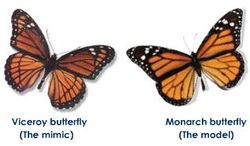Species often interact within an ecosystem to form special relationships. Organisms that interact with each other intimately are said to have symbiotic relationships. There are a number of symbiotic relationships:
| Amensalism (0/-) Amensalism is a relationship where one species is disadvantaged while the other is unaffected. Some molds (such as Penicillin) fall under this category, as they may secrete chemicals that kill bacteria. | Commensalism (+/0) Commensalism is a relationship where one organism benefits while the other is neither harmed nor benefited by the relationship. |
| Mutualism (+/+) Mutualism is a relationship where both species benefit from the interaction. | Neutralism (0/0) Neutralism is a relationship where the species involved do not have any effect on one another. True neutralism is rare in nature due to indirect interactions. |

The Domino Effect
Species do not always influence other species directly. Interactions between species are often indirect in nature, such that a change in one species causes a chain reaction throughout an ecosystem. It is for this reason that neutralism is rarely found in nature.
Keystone Species
Keystone species are species that have strong effects on their ecosystems. However, this is often done in an indirect manner. An ecological web can be examined to determine what effects a change in a species can have on their ecosystem.
Coevolution and Mimicry
When species interact closely within an ecosystem, they are likely to evolve together. More information about coevolution can be found under the Evolution heading at the top.
Species do not always influence other species directly. Interactions between species are often indirect in nature, such that a change in one species causes a chain reaction throughout an ecosystem. It is for this reason that neutralism is rarely found in nature.
Keystone Species
Keystone species are species that have strong effects on their ecosystems. However, this is often done in an indirect manner. An ecological web can be examined to determine what effects a change in a species can have on their ecosystem.
Coevolution and Mimicry
When species interact closely within an ecosystem, they are likely to evolve together. More information about coevolution can be found under the Evolution heading at the top.

In addition to coevolution, mimicry often occurs between species as defense mechanisms.
- Batesian Mimicry: a harmless or palatable species will mimic the appearance of a species that is harmful or unpalatable. A common example of this is the viceroy butterfly and the monarch butterfly. The viceroy butterfly, the palatable species, mimics the monarch butterfly, the unpalatable species.
- Muellerian Mimicry: two harmful or unpalatable species evolve to look similar to each other so that predators avoid both species, and both species benefit.

